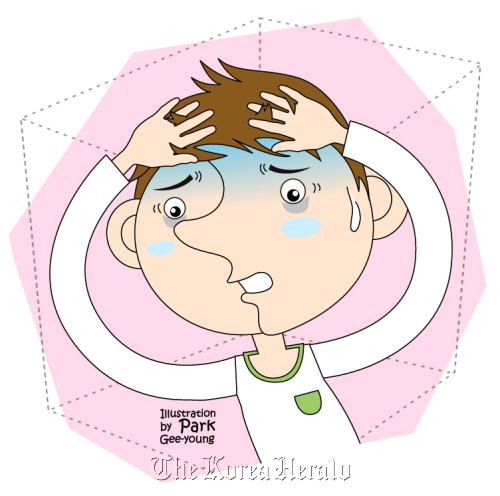Case vignette: “When returning home, I suddenly had a cold sweat, felt dizzy, felt my heart tighten and felt like I could die. Also, I felt like I had difficulty breathing. Also, I not only had numbness in my hands and feet but also felt my heart beating. This was intolerable. I was very nervous that such things would happen again.”
An office worker, Mr. K, experienced a sudden onset of the above symptoms. Now he is worried that he will again have a sudden onset of panic symptoms that are both formidable and painful. Also, he commonly becomes nervous and fearful before he takes the bus or subway or goes shopping in crowded department stores although he had previously done such things with no such feelings.
This is due to a panic disorder. The sudden onset of symptoms is referred to as a pain attack.

Repeated panic attacks are collectively termed a panic disorder.
Prevalence: According to epidemiological studies, 1.5-5 percent of the population is diagnosed with a panic disorder at least once in their lifetime. It can therefore be inferred that the minimum number of patients with panic disorder is estimated at 700,000 in Korea.
Symptoms
Clinical characteristics of panic attacks are similar to cardiovascular symptoms such as myocardial infarction or angina pectoris. Therefore, there are some people who are worried that they could die of a heart attack.
But this is not the case. Due to temporary derangements of the autonomous nervous system because of panic attacks, patients are presented with a variety of symptoms. When panic attacks disappear, however, the activity of ANS returns to normal.
It is apparent that a panic disorder makes patients both nervous and uncomfortable. But there are no cases where patients die of its symptoms or other life-threatening ones.
There is a high possibility that patients might have recurrent episodes of a panic disorder if they are left untreated. It can therefore be considered a disease that causes great pain and discomfort for patients. With systematic treatment of a panic disorder through expert consultation, however, most patients no longer need be greatly fearful of or afflicted with a panic disorder.
In most cases, a one- to two-year long-term treatment is essential for achieving a complete cure. In making a differential diagnosis, patients should be examined for other medical diseases or neurological deficits.
For example, cardiovascular diseases such as myocardial infarction have symptoms similar to panic attacks. Accordingly, these somatic diseases should be ruled out in making a diagnosis of a panic disorder through clinical/laboratory examinations such as a hematology, a chest X-ray or an electrocardiography at the outpatient clinic or an emergency care center.
Treatments
Pharmacological treatment: Selective serotonin reuptake inhibitors are the most widely used medications for the pharmacological treatment of a panic disorder. In addition, such drugs as serotonin-noradrenaline reuptake inhibitors, tricyclic anti-depressants and benzodiazepines are also useful.
Cognitive-behavioral therapy: Through cognitive-behavioral therapy where patients themselves actively participate in the treatment, patients’ wrong recognition of or attitude toward panic attacks are improved and their behavior is corrected.
Psychotherapy: In-depth psychotherapy, including of the psychoanalytic variety, can improve the symptoms of a panic disorder by analyzing their unconscious meanings.
Biofeedback therapy: Biofeedback therapy is a treatment program based on a physiological feedback mechanism, where patients train themselves to relieve tension by directly monitoring their own physiological signs on a computer screen.
An office worker, Mr. K, experienced a sudden onset of the above symptoms. Now he is worried that he will again have a sudden onset of panic symptoms that are both formidable and painful. Also, he commonly becomes nervous and fearful before he takes the bus or subway or goes shopping in crowded department stores although he had previously done such things with no such feelings.
This is due to a panic disorder. The sudden onset of symptoms is referred to as a pain attack.

Repeated panic attacks are collectively termed a panic disorder.
Prevalence: According to epidemiological studies, 1.5-5 percent of the population is diagnosed with a panic disorder at least once in their lifetime. It can therefore be inferred that the minimum number of patients with panic disorder is estimated at 700,000 in Korea.
Symptoms
Clinical characteristics of panic attacks are similar to cardiovascular symptoms such as myocardial infarction or angina pectoris. Therefore, there are some people who are worried that they could die of a heart attack.
But this is not the case. Due to temporary derangements of the autonomous nervous system because of panic attacks, patients are presented with a variety of symptoms. When panic attacks disappear, however, the activity of ANS returns to normal.
It is apparent that a panic disorder makes patients both nervous and uncomfortable. But there are no cases where patients die of its symptoms or other life-threatening ones.
There is a high possibility that patients might have recurrent episodes of a panic disorder if they are left untreated. It can therefore be considered a disease that causes great pain and discomfort for patients. With systematic treatment of a panic disorder through expert consultation, however, most patients no longer need be greatly fearful of or afflicted with a panic disorder.
In most cases, a one- to two-year long-term treatment is essential for achieving a complete cure. In making a differential diagnosis, patients should be examined for other medical diseases or neurological deficits.
For example, cardiovascular diseases such as myocardial infarction have symptoms similar to panic attacks. Accordingly, these somatic diseases should be ruled out in making a diagnosis of a panic disorder through clinical/laboratory examinations such as a hematology, a chest X-ray or an electrocardiography at the outpatient clinic or an emergency care center.
Treatments
Pharmacological treatment: Selective serotonin reuptake inhibitors are the most widely used medications for the pharmacological treatment of a panic disorder. In addition, such drugs as serotonin-noradrenaline reuptake inhibitors, tricyclic anti-depressants and benzodiazepines are also useful.
Cognitive-behavioral therapy: Through cognitive-behavioral therapy where patients themselves actively participate in the treatment, patients’ wrong recognition of or attitude toward panic attacks are improved and their behavior is corrected.
Psychotherapy: In-depth psychotherapy, including of the psychoanalytic variety, can improve the symptoms of a panic disorder by analyzing their unconscious meanings.
Biofeedback therapy: Biofeedback therapy is a treatment program based on a physiological feedback mechanism, where patients train themselves to relieve tension by directly monitoring their own physiological signs on a computer screen.

By Yu Bum-hee, MD, Ph.D
The author is a professor at Sungkyunkwan University School of Medicine and doctor at Department of Psychiatry of Samsung Medical Center. ― Ed.
-
Articles by Korea Herald


![[AtoZ into Korean mind] Humor in Korea: Navigating the line between what's funny and not](http://res.heraldm.com/phpwas/restmb_idxmake.php?idx=644&simg=/content/image/2024/04/22/20240422050642_0.jpg&u=)
![[Exclusive] Korean military set to ban iPhones over 'security' concerns](http://res.heraldm.com/phpwas/restmb_idxmake.php?idx=644&simg=/content/image/2024/04/23/20240423050599_0.jpg&u=20240423183955)



![[Graphic News] 77% of young Koreans still financially dependent](http://res.heraldm.com/phpwas/restmb_idxmake.php?idx=644&simg=/content/image/2024/04/22/20240422050762_0.gif&u=)
![[Herald Interview] Why Toss invited hackers to penetrate its system](http://res.heraldm.com/phpwas/restmb_idxmake.php?idx=644&simg=/content/image/2024/04/22/20240422050569_0.jpg&u=20240422150649)






![[Exclusive] Korean military to ban iPhones over security issues](http://res.heraldm.com/phpwas/restmb_idxmake.php?idx=652&simg=/content/image/2024/04/23/20240423050599_0.jpg&u=20240423183955)



![[Today’s K-pop] Ateez confirms US tour details](http://res.heraldm.com/phpwas/restmb_idxmake.php?idx=642&simg=/content/image/2024/04/23/20240423050700_0.jpg&u=)